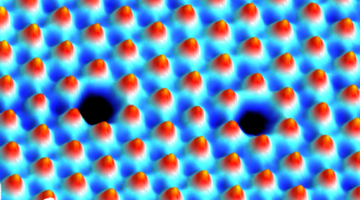Low-dimensional materials exhibit excellent properties for use in next-generation electronic devices. Now, researchers have discovered an ideal platform for tuning between 1D and 2D physics, expanding the possibilities for device engineering and offering a versatile platform for the exploration of intriguing low-dimensional physics. Read more »
A Topological-Insulator Sandwich for Efficient Microelectronics
Researchers synthesized a topological insulator between two ferromagnetic layers and found that it is electronically characterized by a large magnetic band gap. The results open a new path toward lossless charge transport and perfect spin polarization, which could lead to the development of ultralow-energy electronics and spintronics. Read more »![]()
![]()
A Novel Insulating State Emerges in a 2D Material
Researchers found a unique insulating state in an atomically thin material, driven by the combined effects of lattice–charge interactions and atomic-bond formation. The work provides a better understanding of charge ordering in two-dimensional materials and opens up new possibilities for achieving designer electronic properties. Read more »![]()
![]()
Interlayer Coupling Drives Mysterious Phase Transition
Researchers found that a mysterious phase transition in an iron-based superconductor is driven by interactions between the material’s 2D layers. The results counter the assumption that interlayer coupling is negligible in such materials, suggesting instead that the interactions can be an effective way to tune superconductivity. Read more »![]()
![]()
This Exotic Particle Had an Out-of-Body Experience; These Scientists Took a Picture of It
Scientists have taken the clearest picture yet of electronic particles that make up a mysterious magnetic state called a quantum spin liquid (QSL), in which electrons decompose into spin-like particles (spinons) and charge-like particles (chargons). The achievement could facilitate the development of superfast quantum computers and energy-efficient superconductors. Read more »
Tuning Semimetallicity Using Thin Films and Interfaces
With support from ALS data, scientists gained new insight into a semimetal’s unusual electronic behavior. The work lays out a basic strategy for engineering the band structures of semimetallic compounds using dimensional confinement and reveals a new way of creating two-dimensional electron/hole gases by exploiting interfacial bonding. Read more »![]()
![]()
Actor in a Supporting Role: Substrate Effects on 2D Layers
ALS studies highlighted interactions that can occur between technologically intriguing 2D materials and the substrates that physically support them. The results provide important insights into the issue of non-negligible interlayer coupling and demonstrate the potential for tuning single-layer properties through substrate engineering. Read more »
The Beauty of Imperfections: Linking Atomic Defects to 2D Materials’ Electronic Properties
Two studies reveal surprising details on how some atomic defects emerge in transition metal dichalcogenides (TMDs), and how those defects shape the material’s electronic properties. The findings could provide a more platform for designing 2D materials for quantum information science and smaller, more powerful optoelectronics. Read more »
Chiral Crystals Give Rise to Topological Conductors
Researchers have discovered materials whose chiral crystal structures produce chirality in their electronic behavior. These topological conductors retain their unique electronic properties regardless of defects and open new possibilities in materials research. Read more »
The Best Topological Conductor Yet: Spiraling Crystal Is the Key to Exotic Discovery
Researchers have discovered the strongest topological conductor yet, in the form of thin crystal samples that have a spiral-staircase structure. The realization of so-called topological materials—which exhibit exotic, defect-resistant properties and are expected to have applications in electronics, optics, quantum computing, and other fields—has opened up a new realm in materials discovery. Read more »









